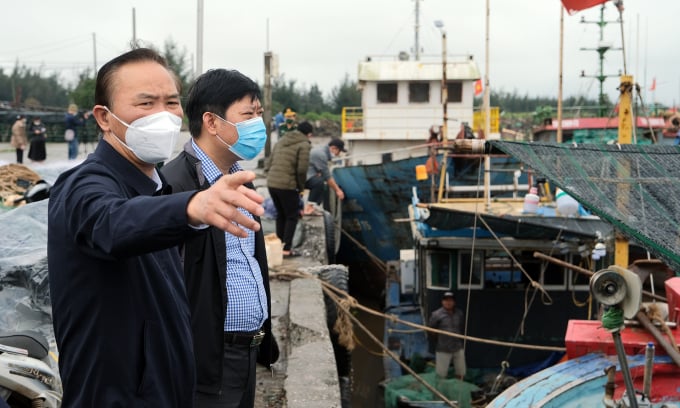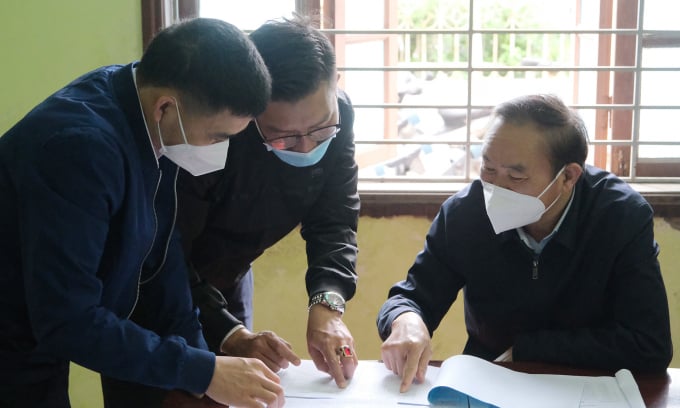November 22, 2025 | 22:06 GMT +7
November 22, 2025 | 22:06 GMT +7
Hotline: 0913.378.918
November 22, 2025 | 22:06 GMT +7
Hotline: 0913.378.918

Deputy Minister of Agriculture and Rural Development Phung Duc Tien and Deputy Director-General of the General Department of Fisheries Nguyen Quang Hung inspect the fishing port of Cua Lan, Tien Hai district, Thai Binh province. Photo: Bao Thang.
On March 24, inspecting the actions against the IUU-fishing situation at Cua Lan fishing port, Tien Hai district, Thai Binh province, Deputy Minister of Agriculture and Rural Development Phung Duc Tien emphasized the importance of removing the yellow card, which is a common task of all levels and sectors.
"With the flow of agriculture, fishery industries need to be exploited sustainably. Against IUU-fishing is a measure to help achieve that goal. It helps raise Vietnam's position on the world and build a clean and green environment for the next generation", the Deputy Minister shared.
According to the Deputy, units involved in the fight against IUU-fishing must constantly ask, "when will the IUU yellow card be removed". He said all would have coordination and synchronization only when struggling with that thought, turning thinking into action.
Having worked many times with the European Commission (EC), Deputy Minister Phung Duc Tien noted Thai Binh province in particular and 28 coastal provinces and cities. This organization always carries out strict inspection work against IUU-fishing. Therefore, the fight against IUU-fishing cannot be neglected for a single moment.
"If ships are not controlled, it leads to the consequences of not being able to trace the source of exploited seafood. Managing a large fleet of ships is not an easy task, requiring a clear decentralization in the implementation work", the Deputy Minister stated.
Recently, Thai Binh province has promoted the installation of cruise monitoring equipment on fishing boats. The installation rate in the whole province is about 940%. However, Deputy Minister Phung Duc Tien reminded the province more closely. He mentioned the reality in some places that ships lying on the shore still have navigation devices on. Therefore, fleet management is still the most critical factor in yellow card removal for IUU-fishing.
At the meeting, the Deputy Minister of Agriculture and Rural Development asked about the catches caught through Cua Lan port, the number of boats and turned over each logbook to compare and observe the port management.
In addition to upgrading infrastructure, the Deputy Minister noted the issue of propaganda and awareness-raising for fishers. The Deputy Minister said that the object for propaganda is fishers, but they are rarely on land. Therefore, the propaganda forms need to be diverse and rich. In addition to regular checks and reminders, the fishing port management boards need to promote the use of loudspeakers, distribute leaflets, and even go to the fishers' houses to mobilize.

Deputy Minister Phung Duc Tien (on the right) checks logs of ships at Cua Lan port. Photo: Bao Thang.
Thai Binh is a province with great potential for fisheries, with a coastline of nearly 50 kilometers and a total water surface area of almost 16,000 hectares. According to the Department of Agriculture and Rural Development of Thai Binh province, the province's total seafood production in 2021 reached 272,120 tonnes, up 4.5%; production value reached 5,574.8 billion, an increase of 4.19% compared to 2020. The exploitation output reached 96,611 tonnes, the value of exploitation reached VND1,456 billion.
In recent years, the number of fishing vessels exploiting seafood in the high seas and inland areas has grown, and the number of fishing boats operating inshore has gradually decreased. By March 2022, the total number of fishing vessels registered and entered into the national fishing vessel database software Vnfishbase is 736 fishing vessels.
Regarding aquaculture, Thai Binh continues to develop a variety of methods such as cages, rafts, tidal flats... and uses farm animals of economic value including sardines, red snapper, yellowfin pompano, etc. grouper, tortoise, barramundi, brown fish, catfish.
Identifying seafood as a major source of revenue for the local budget, but Thai Binh still faces some difficulties in promoting this activity. The reason is that the price of gasoline has increased so that most of the owners of fishing boats lying on the shore do not go fishing; Aquaculture activities are mainly produced by individual households, with small and odd areas, asynchronous infrastructure, low productivity; 80% of the breeding stock must be imported from foreign provinces, the quality is difficult to control, the risk of disease outbreak is high.
Through the inspection of Cua Lan port and a visit to some aquaculture establishments and aquatic breeds of Thai Binh province, Deputy Minister Phung Duc Tien highly appreciated the restructuring efforts and investment boldness of the provincial fisheries sector.
To help Thai Binh province speed up agricultural development, the Deputy Minister suggested that the province focus on developing solid products, improve quality to achieve geographical indication recognition, and assigned the Directorate of Fisheries to coordinate with the province to exploit maximum potential water surface area. He also said he would support the province in upgrading and developing the infrastructure of the concentrated clam seed production area in Thai Thuy district.
Translated by Ha Phuc

(VAN) Viet Nam’s forestry sector is undergoing a comprehensive transformation, strengthening management, protection, and development efforts to maintain ecological security and drive green, sustainable growth.

(VAN) Viet Nam is accelerating efforts to digitize reservoir operations, from real-time data to hydraulic modelling.
/2025/11/21/3348-2-102623_454.jpg)
(VAN) National Assembly delegate Nguyen Thi Lan has proposed adding special mechanisms to attract human resources to the agricultural, forestry, and fishery sectors, addressing the shortage of high-quality personnel.

(VAN) Over the past two decades, the unified legal framework for water resource management has been perfected, becoming a crucial foundation for ensuring national water security.

(VAN) The land-data cleansing campaign in Dien Bien is entering its final stretch, yet weak infrastructure, limited personnel and fragmented multi-period datasets continue to create major obstacles.
/2025/11/20/0204-2-115235_496.jpg)
(VAN) Not only do carbon credits bring a great revenue source, but they also contribute to better forest protection and development. However, this potential remains largely untapped.

(VAN) Applying modern technology is helping environmental monitoring and oversight of management quality.